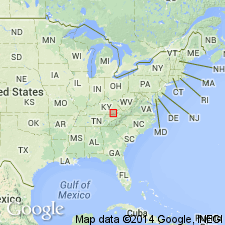
- Usage in publication:
-
- Stoney Fork Member*
- Modifications:
-
- Original reference
- Dominant lithology:
-
- Limestone
- Sandstone
- AAPG geologic province:
-
- Appalachian basin
Summary:
Pg. A45; p. A70-A76. Stoney Fork Member of Breathitt Formation. Medium-dark-gray shale, limestone, siltstone, and sandstone in upward coarsening sequence; contains siderite layers or nodules. Thickness 10.43 m; ranges 6 to 12 m. Upper contact placed where siltstone of the Stoney Fork is overlain by cross-bedded channel-fill sandstone, thick-bedded or massive sandstone, or an unnamed coal bed. Lower contact placed at base of fossiliferous zone that overlies coal, commonly the Hindman (Hazard No. 9) coal bed, underclay, or sandstone. Lies about 171 m above Magoffin Member of Breathitt Formation and about 232 m above the Fire Clay coal bed. Replaces Lost Creek Limestone (preempted) of Morse (1931). Fossils (fusulinids). Age is Middle Pennsylvanian (Atokan).
Type section: exposures above a strip bench about 350 m southeast of KY Highway 1201 at head of Red Bird Creek, approx. 4.8 km southwest of the community of Beverly, Lat. 36 deg. 53 min. 46 sec. N., Long. 83 deg. 33 min. 36 sec. W., Beverly 7.5-min quadrangle, Bell Co., southeastern KY. Named from settlement of Stoney Fork, about 8 km south of type section, Balkan 7.5-min quadrangle, Bell Co., southeastern KY.
Source: Publication; US geologic names lexicon (USGS Bull. 1564, p. 165).
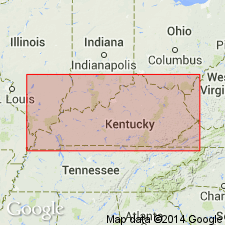
- Usage in publication:
-
- Stoney Fork Member
- Modifications:
-
- Revised
- AAPG geologic province:
-
- Appalachian basin
Summary:
Breathitt Formation is informally elevated to group rank and subdivided into the following eight informal formations: Pocahontas, Bottom Creek, Alvy Creek, Grundy, Pikeville, Hyden, Four Corners, and Princess formations. Stoney Fork Member is assigned to the base of the Princess formation. Underlies Main Block ore beds and overlies Hindman coal of the Four Corners formation. [Revisions made in this paper are strongly contested by C. Rice and other USGS scientists who work in this area (oral commun., 9/3/93).]
Source: GNU records (USGS DDS-6; Reston GNULEX).
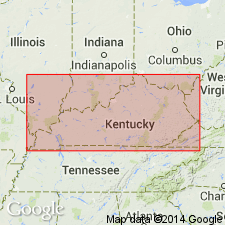
- Usage in publication:
-
- Stoney Fork Member
- Modifications:
-
- Revised
- AAPG geologic province:
-
- Appalachian basin
Summary:
Stoney Fork Member is assigned to the base of the formally named Princess Formation, uppermost unit of Breathitt Group. Overlies coal-bearing strata of Four Corners Formation (new) and underlies various named and unnamed coal beds of the upper part of the Princess. Although the Stoney Fork is widespread across most of eastern KY, it has not been identified in the Princess District, the type area of the Princess Formation. A reference section for the lower part of the Princess in Perry Co., described in the appendix, includes the Stoney Fork, which composed of about 32 ft of sandstone, shale, and claystone. Member's occurrence is queried in the TN, VA, and WV portions of the Cumberland plateau on the correlation chart (plate 8). A generalized Pennsylvanian age is shown for all of the Breathitt. According to the author, formal nomenclature presented in this report for units occurring in KY has been accepted by the Kentucky Stratigraphic Nomenclature Committee. Units that occur largely outside KY are considered informal. Report includes correlation charts, cross sections, and measured sections.
Source: GNU records (USGS DDS-6; Reston GNULEX).
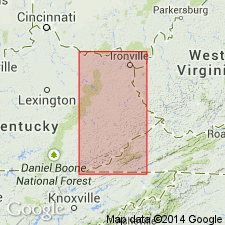
- Usage in publication:
-
- Stoney Fork Member*
- Modifications:
-
- Areal extent
- AAPG geologic province:
-
- Appalachian basin
Summary:
Stoney Fork Member of Breathitt Formation. [Marine limestone and shale, 20 to 40 feet thick] in upper part of Breathitt Formation below the informal, unranked Flint Ridge flint or Limekiln limestone (= Kilgore Flint Member of Princess district) and above Arnett Member; between the Hazard No. 10 (or Tiptop) coal bed and Hazard No. 9 (or Hindman) coal bed. [Correlates with Blunt Run (Boggs) limestone of Pottsville Formation in Ohio.] Replaces Lost Creek Limestone of Morse (1931). [Fossils.] Age is Middle Pennsylvanian.
Recognized in Licking River, Hazard, and Southwestern districts, eastern KY.
[See also Rice and others, 1994, GSA Spec. Paper 294, p. 7-26; and Rice and others, same vol., p. 148.]
Source: Publication.
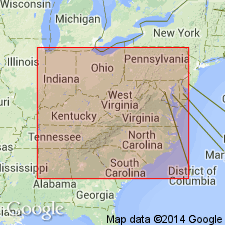
- Usage in publication:
-
- Stoney Fork Member
- Modifications:
-
- Areal extent
- AAPG geologic province:
-
- Appalachian basin
Summary:
Corr. chart. Stoney Fork Member of Princess Formation of Breathitt Group. Shale and/or mudstone. Is basal member of Princess Formation in eastern Kentucky. Lies below the upper Broas (Princess No. 4) coal zone; is separated from it by sandstone called "Main Block ore." Lies above Four Corners Formation of Breathitt Group. Correlates with Lake City member, an informal member of Cross Mountain Formation in Tennessee, and Blunt Run (Boggs) limestone, an informal, unranked unit in upper part of Pottsville Group in Ohio. Carries marine fossils. Age is Middle Pennsylvanian (Westphalian; Atokan).
[Peppers (1996, GSA Memoir 188, p. 9, pl.) placed the Princess No. 4 coal in Westphalian C, TORISPORA SECURIS-T. LAEVIGATA (SL) miospore assemblage zone of western Europe. Unpublished collections from the Stoney Fork and its equivalents, informal Lake City member of Cross Mountain Formation in Tennessee and Blunt Run (Boggs) limestone of Pottsville Group in Ohio, yielded distinctive conodonts correlative with the marine Aegir bed (=base of Westphalian C) thus shifting the Four Corners, Vowell Mountain, lower part of Cross Mountain, and upper part of Pottsville, downward into Westphalian B (R.G. Stamm, USGS, pers. commun., Oct. 17, 2013).]
[See also Chesnut, 1997 (revised Oct. 12, 1999), Stratigraphy of the coal-bearing strata of the Eastern Kentucky coal field, available online through the Kentucky Geol. Survey (http://www.uky.edu/KGS/coal/coalcorrel.htm) and geologic descriptions of stratigraphic units in the Kentucky Geological Survey database (http://kgs.uky.edu/kgsmap/KGSLitho/lithoSearch.asp#).]
Source: Publication.
For more information, please contact Nancy Stamm, Geologic Names Committee Secretary.
Asterisk (*) indicates published by U.S. Geological Survey authors.
"No current usage" (†) implies that a name has been abandoned or has fallen into disuse. Former usage and, if known, replacement name given in parentheses ( ).
Slash (/) indicates name conflicts with nomenclatural guidelines (CSN, 1933; ACSN, 1961, 1970; NACSN, 1983, 2005, 2021). May be explained within brackets ([ ]).

